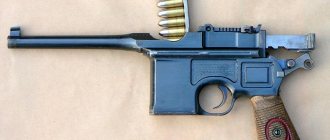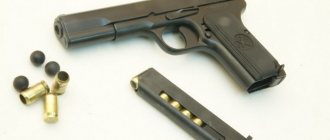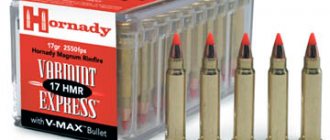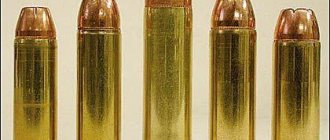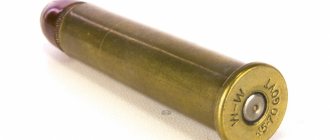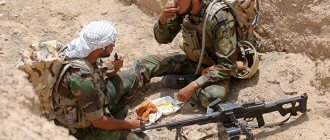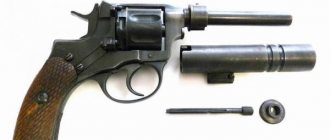In search of the ideal machine gun cartridge, designers stuffed several bullets into a cartridge case, made caseless ammunition or U-shaped plastic cartridges. The center of cartridge discourse in recent years has been the 6.5x39 Grendel and 6.8x43 Remington SPC ammunition. Some experts saw in them the optimal combination of qualities - fairly high power and good flatness of the bullet trajectory with moderate recoil. These cartridges were predicted to play the role of new ammunition for the largest armies or at least for special units. But this page, it seems, will soon be turned.
Consolidating expert opinions, we can say that the task of a modern intermediate/automatic cartridge is to defeat manpower at distances of up to 400 meters. In this case, the emphasis is on shooting from unstable positions - standing from the hands, from the knee - at moving targets. And this involves automatic fire, the effectiveness of which directly depends on the recoil impulse: the higher the recoil, the less effective. As a result, almost all large modern armies use so-called low-impulse cartridges - ammunition of a caliber of about five and a half millimeters with a small recoil impulse: the 5.56x45 NATO cartridge, 5.45x39 in Russia and 5.8x42 in the People's Republic of China. However, small-caliber machine gun cartridges faced many complaints, real and imaginary: insufficient power, high tendency to ricochet, etc.
What happened
Even during the campaigns in Iraq and Afghanistan, the US military complained about the insufficient stopping effect of 5.56 mm bullets. It was then, in the early 2000s, that new cartridges were introduced: 6.5x39 Grendel and 6.8x43 Remington SPC. The first was created by Alexander Arms, and is based on a modified cartridge case of the Soviet 7.62x39 mm cartridge of the 1943 model (used in the AK-47, AKM, SKS carbine). The second was developed by a well-known arms concern in collaboration with experts from the US Special Operations Forces (USSOCOM). Both cartridges were promoted as promising military ammunition, saying that the increased caliber provides better ballistics and more reliable target engagement compared to the standard 5.56x45 cartridge, while maintaining moderate recoil.
Cartridge 6.5 Grendel
Photo: Reginhild/Wikimedia
How can we not remember that the “father of the Russian machine gun,” designer Vladimir Fedorov, considered the 6.5 mm caliber optimal for hand-held automatic weapons and even designed a corresponding cartridge. True, Fedorov’s cartridge can hardly be called intermediate in the modern sense, because its energy was the most “rifle-like” - 3000 joules. The energy of 6.5 Grendel and 6.8 Remington, depending on the type of bullet, ranges from 2200-2600 joules. For comparison, the energy of the Kalashnikov cartridge 7.62x39 millimeters is 2000-2200 joules. Actually, this is also a bit much, if we talk about shooting in bursts from hand. The famous Soviet and Russian gunsmith Vladislav Dvoryaninov, in the monograph “Combat Cartridges of Small Arms,” cited the results of tests of Kalashnikov, Dementyev, Bulkin, Korobov, Rukovishnikov and Sudayev assault rifles in 1947: “when firing with automatic fire from a prone position, and, in particular, , from the “kneeling” and “standing from hand” positions, the dispersion of shots turned out to be significantly greater than from the PPSh-41.” And in the future, designers looked for ways to reduce barrel drift during automatic firing.
By the way, in the USSR back in the 60s they studied the possibility of using a 6.5 mm caliber (of course, it was not Grendel); in particular, it was compared with a small-caliber 5.6 mm cartridge. If you believe the reports given by Dvoryaninov, the recoil impulse of the 6.5 mm cartridge was almost 30 percent higher than that of the 5.6 mm cartridge. The first one lost “in terms of the accuracy of the battle, and therefore in terms of the efficiency of firing from unstable positions.” In terms of the flatness of the bullet trajectory, 6.5 mm cartridges were also inferior to 5.6 cartridges. In addition, the latter were 22 percent lighter and 4.5 percent shorter. As for the lethal, stopping and penetrating action, these indicators for both cartridges turned out to be almost equivalent. As a result, the verdict: “further development of 6.5 mm cartridges is impractical.”
Army and police use[edit]
Serbia is in the process of adopting the Zastava Arms [13] 6.5 mm Grendel rifle as the primary weapon for its armed forces. The rifle, designated M17, is a derivative of the previous issue M70 rifle. [14] The American-made 6.5 mm Grendel rifle can also be adopted by special forces after passing tests at the Technical Test Center. [ citation needed
] Three types of 6.5mm Grendel ammunition produced by Prvi Partizan Užice Serbia will be tested for use with these rifles. [15] [16] [17] [18] [19]
Arrows instead of bullets
In general, at the turn of the 1960s, the Soviet military, like their colleagues from the North Atlantic Alliance, was thinking about moving to micro-caliber systems - four millimeters or less - with high-velocity swept bullets. The benefits of this decision were obvious: low recoil, good flatness and a lightweight cartridge. In the United States, similar developments were carried out within the framework of the SPIW (Special Purpose Individual Weapon) program, which was funded by the Pentagon from 1959 to 1974. In our country, designers Vladislav Dvoryaninov and Dmitry Shiryaev worked on cartridges with arrow-shaped bullets, in particular. They developed prototypes of ammunition, and in 1961 Shiryaev presented the experimental AO-27 assault rifle for firing with feathered needles.
Arrow-shaped bullets
Image: popgun.ru
But the micro-caliber theme had many problems: the cost of cartridges turned out to be very high, the lethality and penetrating effect of thin arrow-shaped bullets were low. In the cartridges, sub-caliber arrow-shaped bullets were held by special plastic pallets, which, flying out of the barrel, could injure their own soldiers in front of the shooter. As for reducing the caliber of the barrel, another problem arose - the so-called capillary effect, water retention due to the force of surface tension and wetting. Moreover, it was not possible to simply shake the water out of the 4.5 millimeter barrel: it could either be blown out or removed with a cleaning rod. And water in the barrel threatened serious trouble: when fired, it could be bent, and in the worst case, it could be torn.
Caseless cartridge of 4.7 mm caliber for the German G11 rifle
Photo: Drake00/Wikimedia
In the 60s, Soviet designers came to the conclusion that the minimum possible caliber of an assault rifle was about five and a half millimeters. If it is less, the set of problems described above arises; if it is more than, say, 6.5 millimeters, there is a decrease in ammunition capacity (due to the greater mass of the cartridge) and a decrease in firing efficiency. That is, even if we assume that one 6.5 mm caliber bullet will fly further and cause more damage to the enemy, on average ten fighters with 5.45 mm caliber weapons will hit more targets than ten fighters with 6.5 mm caliber machine guns. Simply because the former will have a little more ammo and a slightly higher probability of hitting the target for each burst.
Actually, the topic of arrow-shaped bullets and ultra-small calibers for machine guns in the USSR was practically closed. In the West, these areas were developed within the framework of the ACR program until the end of the last century.
Links[edit]
- "6.5mm Grendel (Internet Archive Copy)". Alexander Gerb. Archived from the original on January 9, 2012. Retrieved October 22, 2015.
- ^ ab Guthrie, J (November 16, 2012). "6.5mm Grendel: the round one a military man must have". Shooting time. Retrieved March 8, 2013.
- "Archival copy". Archived from the original on 2016-01-08. Retrieved 4 January 2016.CS1 maint: archived copy as title (link)
- Lewis, Jack (2007). Weapon Digest of Assault Weapons
. Gun Digest Books. paragraph 77. ISBN 978-0-89689-498-3. - ↑
Outdoor Hub, Prototype 6.5 Grendel AK Rifle from Definitive Arms, October 13, 2015 - “Alexander Arms announces: 6.5 Grendel is the official cartridge of SAAMI”
- https://bulletin.accurateshooter.com/2011/10/6-5-grendel-is-approved-as-sammi-cartridge-alexander-arms-gives-up-6-5-grendel-trademark/
- ↑
Case for the Anthony J. Williams General Purpose Rifle and Machine Gun Cartridge (GPC). Archived November 9, 2014, at the Wayback Machine. - Earhart, Thomas P. Rising Small Arms Lethality in Afghanistan: Taking Back an Infantry Half-Kilometer
. pp. 37-38 - Infantry Conference Report - SAdefensejournal.com, January 9, 2012
- ↑
Another 7.62mm bullet for the M-16 - Strategypage.com, January 8, 2012 - ↑
Individual carbine competitions in the army: what's next? — SAdefensejournal.com, October 24, 2013 - "Archival copy". Archived from the original on 2016-08-27. Retrieved 26 July 2016.CS1 maint: archived copy as title (link)
- https://www.thefirearmblog.com/blog/2017/11/22/first-m military
6-5-
grendel
-rifle-
zastava
-m17-
ak
-dmr-
revealed-
serbian-army/ - https://www.prvipartizan.com/search_rb.php?id=A-484
- https://www.prvipartizan.com/search_rb.php?id=A-485
- https://www.prvipartizan.com/search_rb.php?id=A-483
- "Archival copy". Archived from the original on 2016-07-24. Retrieved 26 July 2016.CS1 maint: archived copy as title (link)
- https://www.thetruthaboutguns.com/2016/10/josh-wayner/universal-service-cartridges-will-never-happen/ _
_ - SSK 6.5 MPC cartridge designed by JD Jones at SSK Industries | Article on DefenseReview.com
Excerpt characterizing the 6.5×39mm Grendel
– Cette ville Asiatique aux innombrables eglises, Moscow la sainte. La voila donc enfin, cette fameuse ville! Il etait temps, [This Asian city with countless churches, Moscow, their holy Moscow! Here it is, finally, this famous city! It's time!] - said Napoleon and, dismounting from his horse, ordered the plan of this Moscou to be laid out in front of him and called the translator Lelorgne d'Ideville. “Une ville occupee par l'ennemi ressemble a une fille qui a perdu son honneur, [A city occupied by the enemy is like a girl who has lost her virginity.] - he thought (as he said this to Tuchkov in Smolensk). And from this point of view, he looked at the oriental beauty lying in front of him, whom he had never seen before. It was strange to him that his long-standing desire, which seemed impossible to him, had finally come true. In the clear morning light he looked first at the city, then at the plan, checking the details of this city, and the certainty of possession excited and terrified him. “But how could it be otherwise? - he thought. - Here it is, this capital, at my feet, awaiting its fate. Where is Alexander now and what does he think? Strange, beautiful, majestic city! And strange and majestic this minute! In what light do I appear to them? - he thought about his troops. “Here it is, the reward for all these people of little faith,” he thought, looking around at those close to him and at the troops approaching and forming. – One word of mine, one movement of my hand, and this ancient capital of des Czars perished. Mais ma clemence est toujours prompte a descendre sur les vaincus. [kings. But my mercy is always ready to descend to the vanquished.] I must be generous and truly great. But no, it’s not true that I’m in Moscow, it suddenly occurred to him. “However, here she lies at my feet, playing and trembling with golden domes and crosses in the rays of the sun. But I will spare her. On the ancient monuments of barbarism and despotism I will write great words of justice and mercy... Alexander will understand this most painfully, I know him. (It seemed to Napoleon that the main significance of what was happening lay in his personal struggle with Alexander.) From the heights of the Kremlin - yes, this is the Kremlin, yes - I will give them the laws of justice, I will show them the meaning of true civilization, I will force generations the boyars lovingly remember the name of their conqueror. I will tell the deputation that I did not and do not want war; that I waged war only against the false policy of their court, that I love and respect Alexander, and that I will accept peace terms in Moscow worthy of me and my peoples. I do not want to take advantage of the happiness of war to humiliate the respected sovereign. Boyars - I will tell them: I do not want war, but I want peace and prosperity for all my subjects. However, I know that their presence will inspire me, and I will tell them as I always say: clearly, solemnly and grandly. But is it really true that I am in Moscow? Yes, here she is!
External links [edit]
| Wikimedia Commons has media related to 6.5mm Grendel . |
- https://www.alexanderarms.com/
| vteCartridges derived from 7.62×39mm or its derivatives | ||
| First generation derivatives |
| |
| Second generation derivatives (based on 5.6x39mm / .220 Russian) |
| |
| Third generation derivatives (based on 6.5 mm Grendel) |
|
Bibliography[edit]
- Guns 'n' Ammo: The AR-15 Book, 2004, "6.5mm Grendel", David Fortier, page 66.
- Special Weapons for Military and Police, Yearbook No. 27 2004, “Beyond 5.56mm NATO,” Stan Crist, pp. 62–67.
- Guns 'n' Ammo: The AR-15 Book, 2005, "6.5mm Grendel and 6.8 SPC", David Fortier, pp. 32–44.
- Shooting Times, February 2005, “Preparing the Load for the 6.5mm Grendel,” David Fortier, pp. 52–56.
- Shooting Illustrated, September 2005, "6.5mm Grendel and Alexander Arms", J. Guthrie, pp. 34–37, 67–69.
- Petersen's: Rifle Shooter, March/April 2006, "Cartridge Performance—Why Case Shape Matters," M. L. McPherson, pp. 22–24.
- Shooting Times, January 2007, “Other AR Chambers,” sidebar article, David Fortier, page 56.
- Special Weapons, Semi-Annual #50 2007, "The Super Versatile AR", Charlie Cutshaw, pp. 44–45, 80–83.
- Special Weapons, Semi-Annual #50 2007, "5.56mm NATO Alternatives," Stan Crist, pp. 52–59.
- Shooting Times, March 2007, "Les Baer's 6.5mm Grendel AR Sets a New Standard," David Fortier, pp. 26–32.
- Military & Police Special Weapons #52, Spring 2007, "BETTER-IDEA 6.5mm GRENDEL" by Stan Crist.
- Military and Police Special Weapons #52, Spring 2007, "New Battlefield Requirements - New Rifles and Ammo" by Charlie Cutshaw
